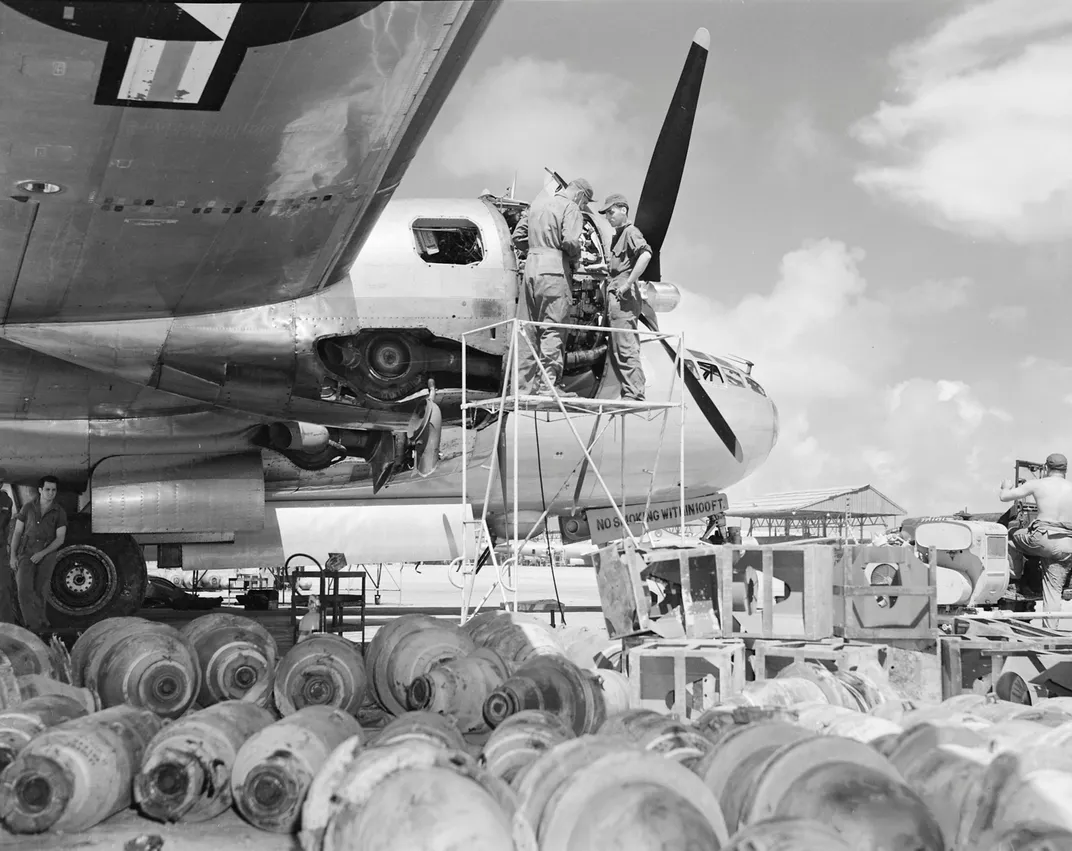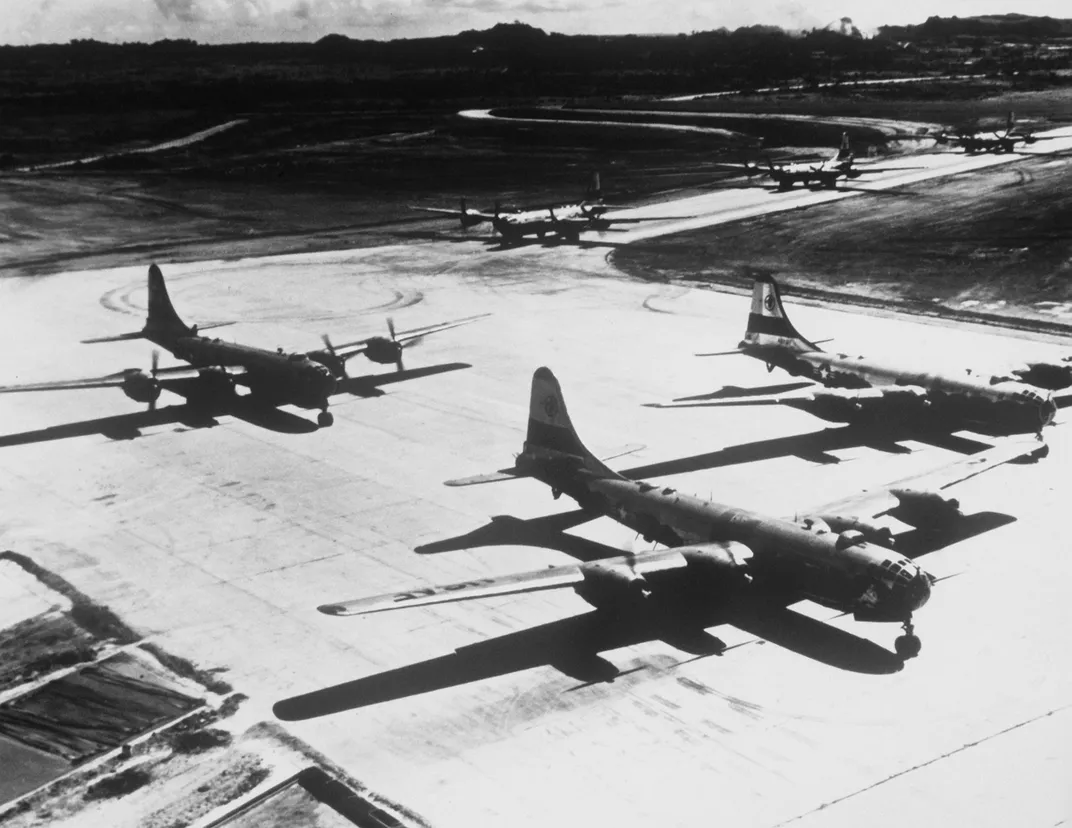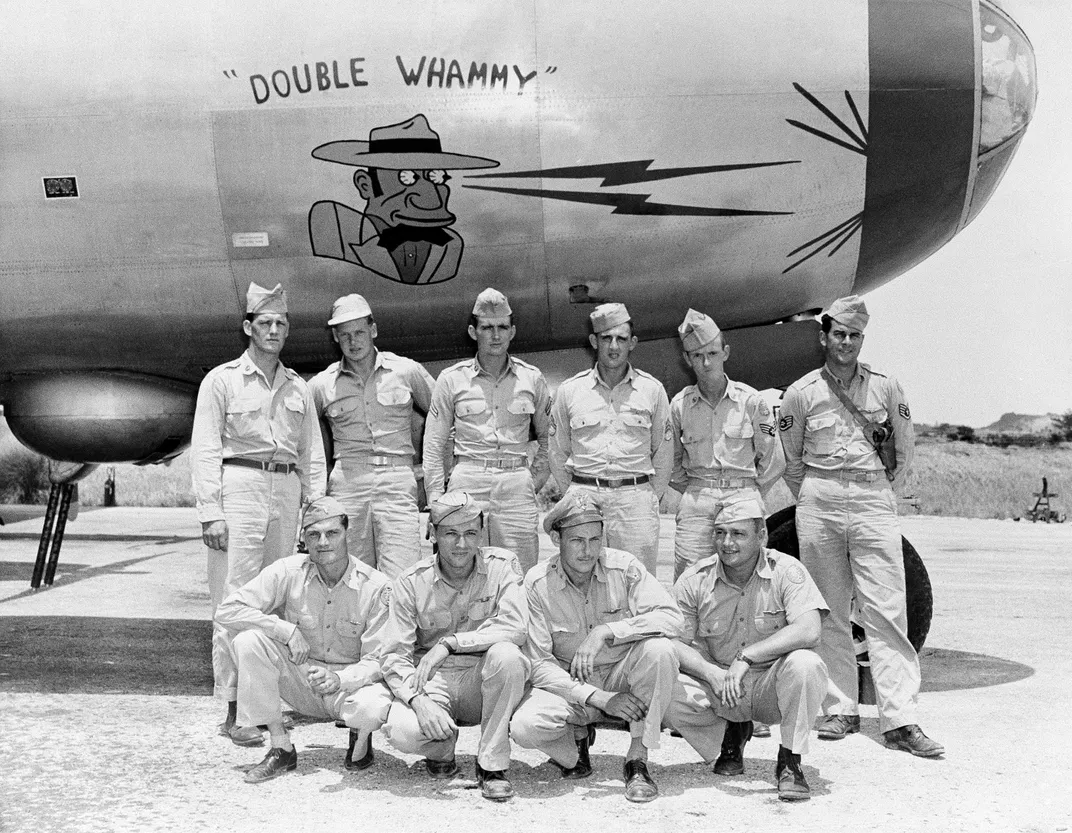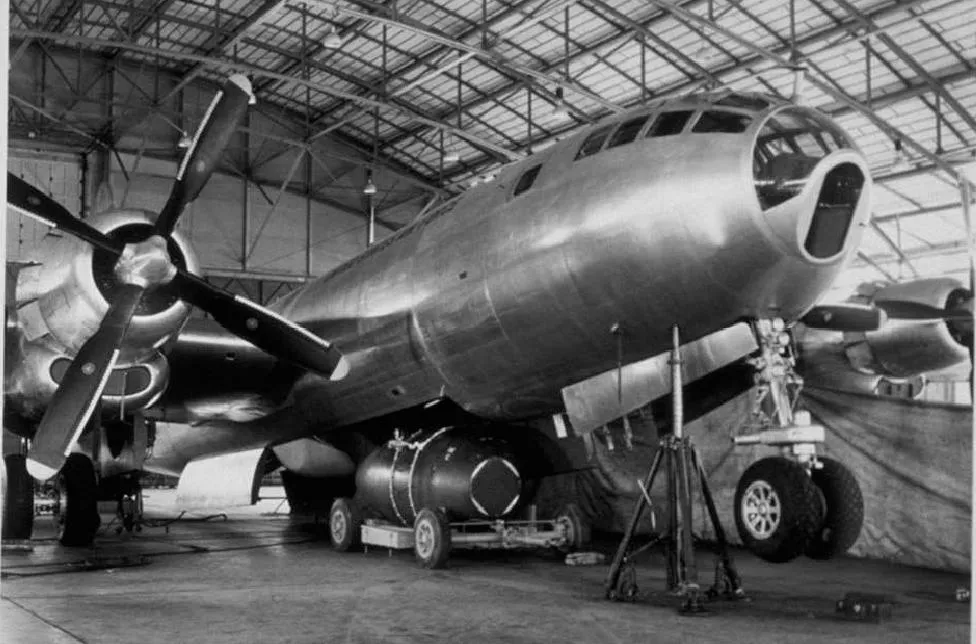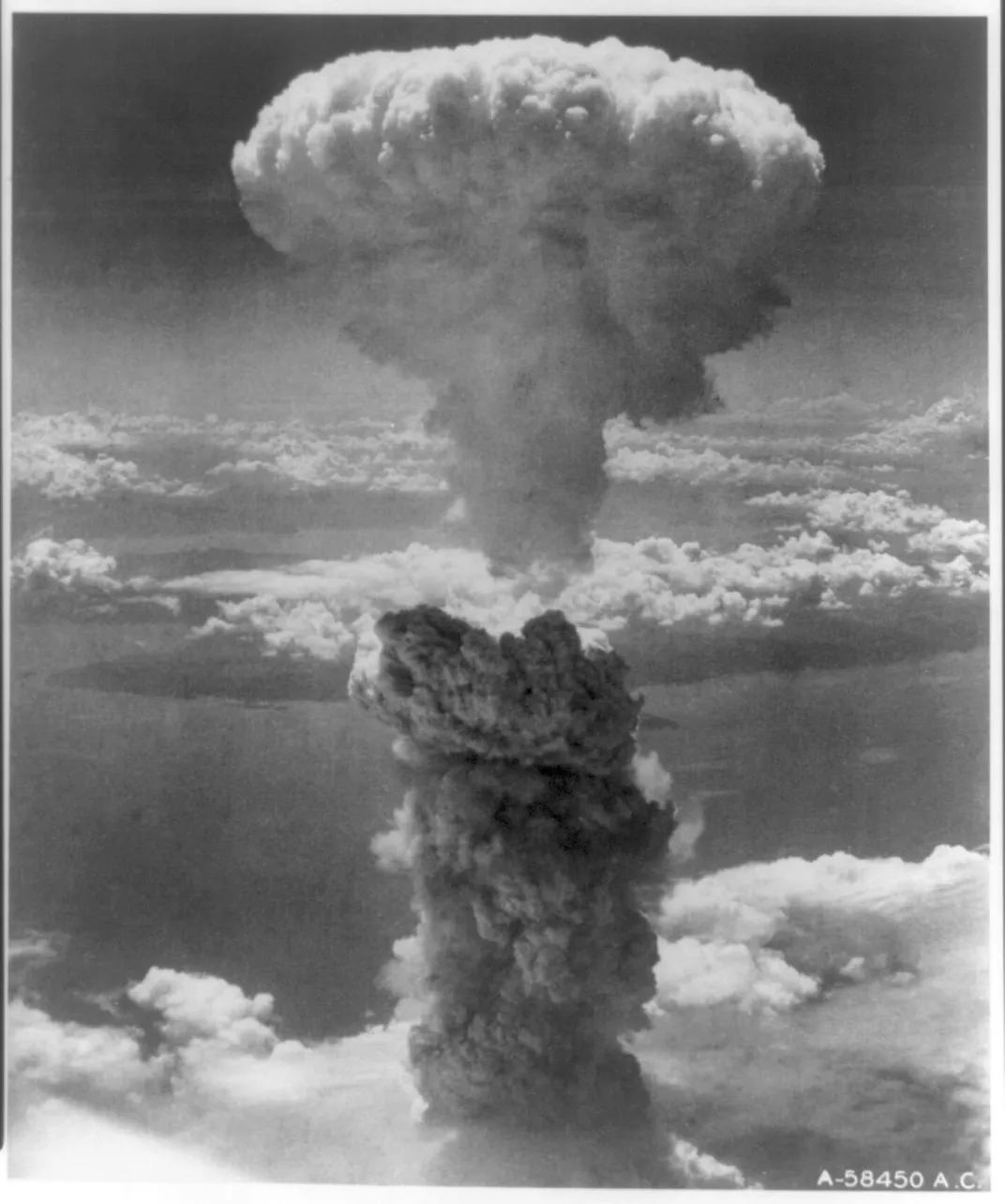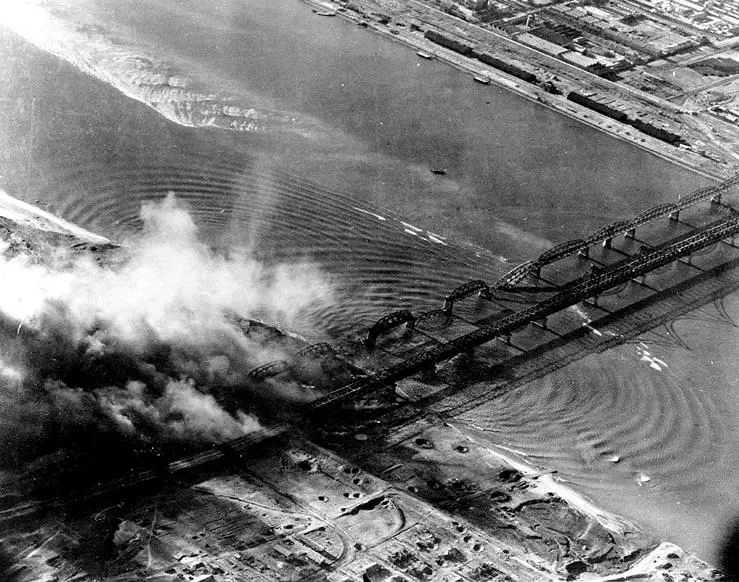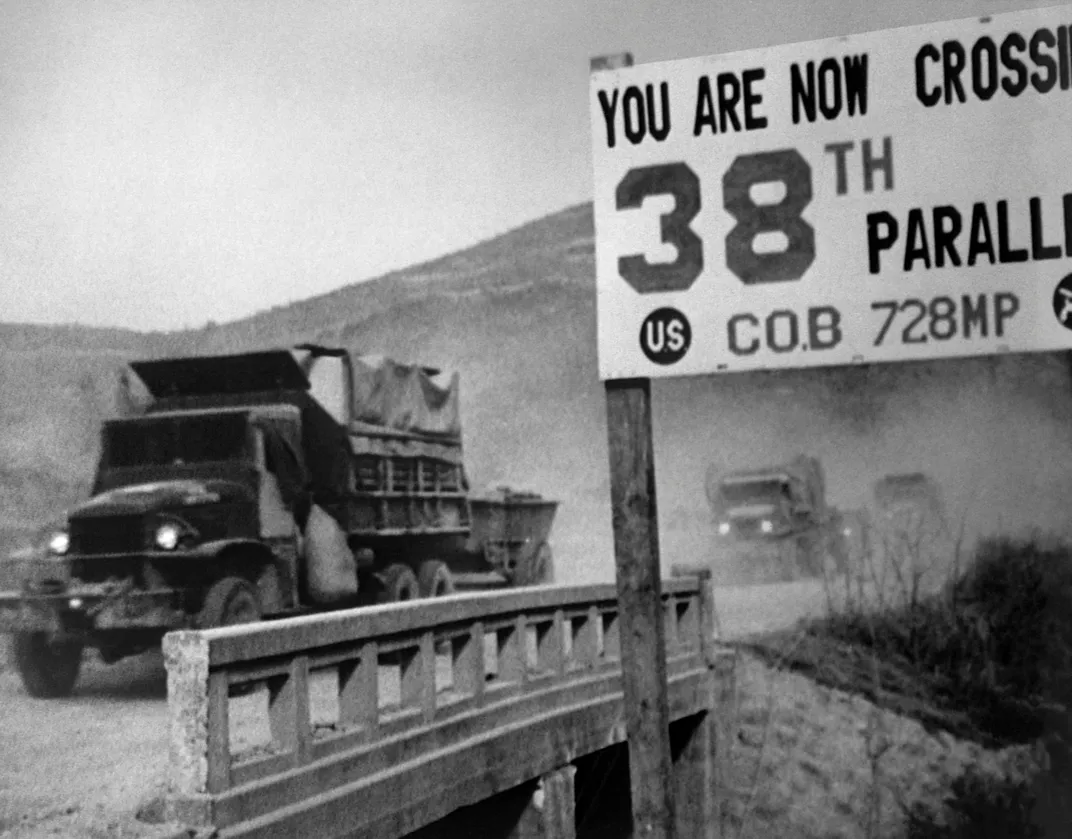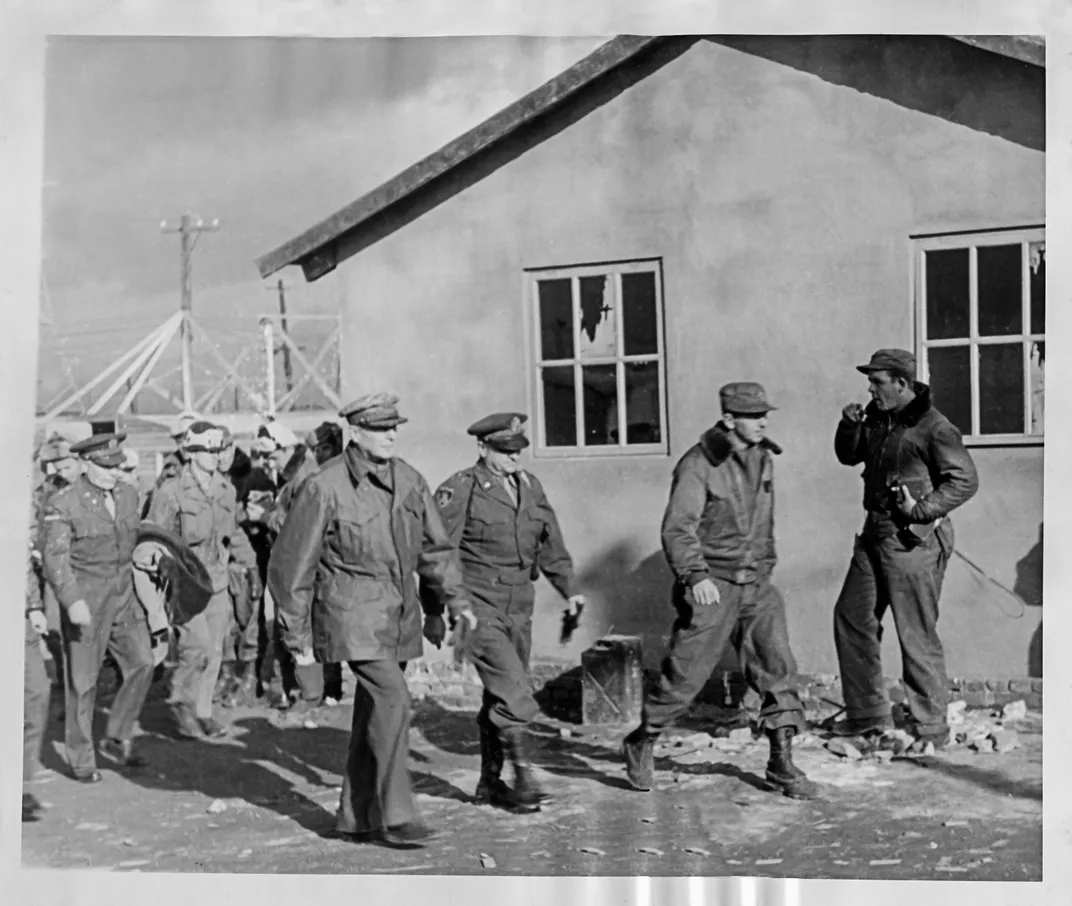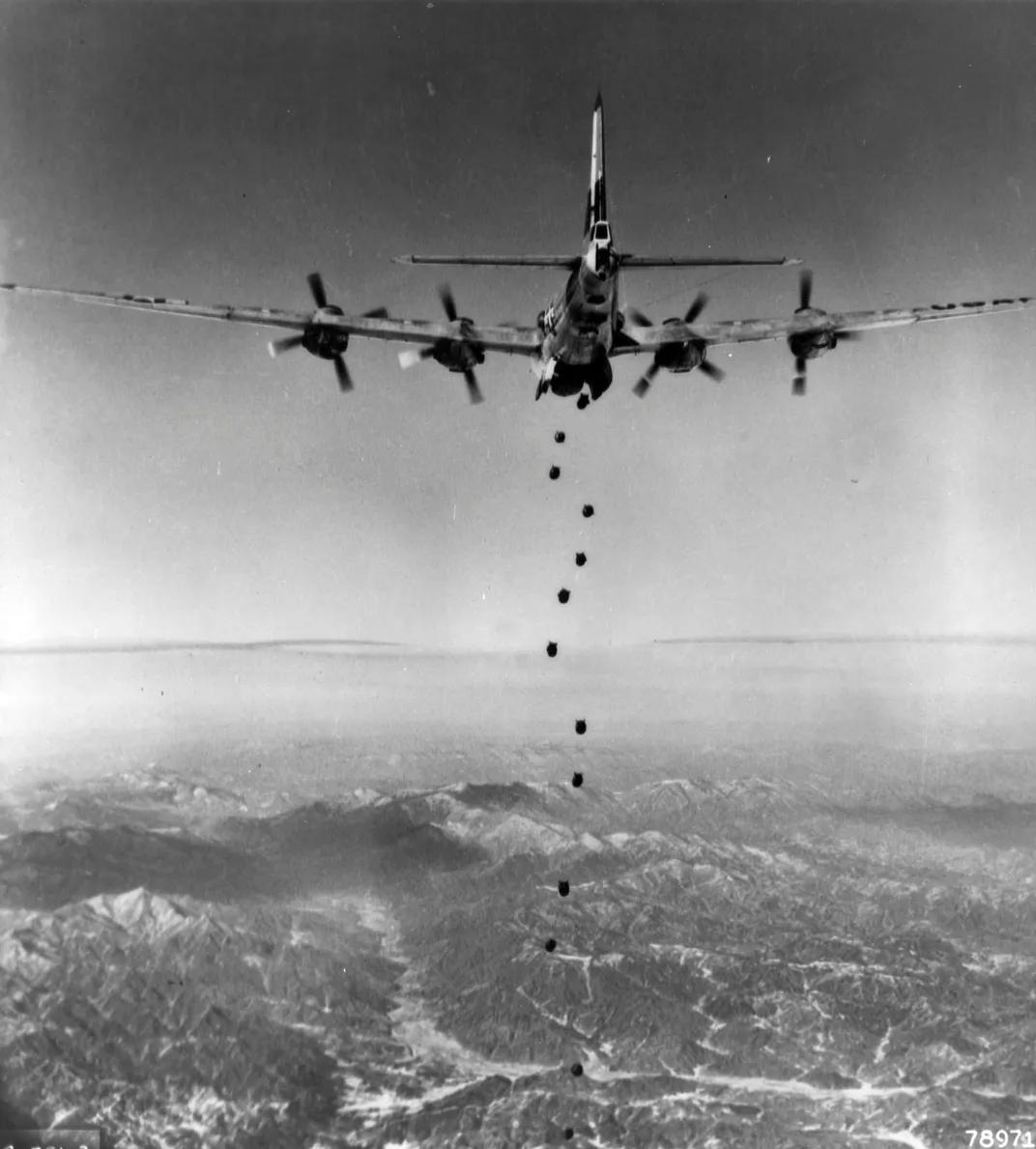How the Korean War Almost Went Nuclear
In 1950, Harry Truman had to decide whether to use B-29s to drop atomic bombs.
/https://tf-cmsv2-smithsonianmag-media.s3.amazonaws.com/filer/0f/76/0f76c3d4-f2f8-4593-a0fb-5237faac709a/01h_dj2015_briefing98thbomgwing_live.jpg)
On the final night of World War II, hundreds of U.S. Army Air Forces B-29s swarmed over Japan, severing the frayed threads of Japanese resistance. Coming at the end of a long war, those mid-August 1945 missions should have been a curtain call for the world’s preeminent heavy bomber.
The following year, most of the thousands of Boeing Superfortresses that had served in the Pacific were stored at the vast Davis-Monthan airfield near Tucson, Arizona, to be mothballed or scrapped. The airplane that had demonstrated that one bomber could destroy a city with one bomb would, it was assumed, hand the baton to a rising generation of bombers powered by jet engines. As it turned out, the B-29’s retirement didn’t last. Although underpowered and inclined to engine fires, the Superfortress remained America’s indispensable airplane—the only one in the world configured to deliver the enormous plutonium bombs of the day.
In January 1950, U.S. intelligence analysts predicted trouble in Korea. Like Germany, the country had emerged from World War II divided. The Soviet Union occupied Korean territory north of the 38th parallel; the United States occupied the south. The north inherited much of the infrastructure—bridges, railroads, hydroelectric complexes, and heavy industry—remaining from more than 30 years of Japanese occupation, less what the Soviets had taken home at the end of the war. The south was the peninsula’s rice bowl.
The intelligence community, noting Soviet-equipped North Korean troops massed north of the 38th parallel, predicted an attack in June. Few took the prediction seriously, but on Sunday, June 25, North Korean ground and air forces poured into South Korea, beginning what might be called the First Korean War.
Fought mostly with the weapons of World War II, this Korean War would also debut a new kind of aerial combat, in which jets fought jets. This war, in which each side won and lost the advantage more than once, consumed hundreds of thousands of lives.
There was a second Korean war, one that has been studied and discussed even less than the first, which some have called “the forgotten war.” The second one was nuclear. It consisted of a series of threats, feints, and practice runs, and it very nearly made it to the Korean battlefield.
the u.s. far east air force (FEAF) quickly mobilized its modest post-World War II resources. Three days after the invasion, four B-29s from the 19th Bombardment Group struck what military targets they could find in the narrow band between Seoul, the capital of South Korea, and the 38th parallel, just to the north of the city.
The bombers had been stationed at Andersen Air Force Base, on Guam, then moved to Kadena Air Base, on Okinawa, which put them within 800 miles of the battle zone. Two days later, 15 Superforts attacked North Korean forces massing along the north bank of the Han River in preparation for moving on Seoul.
The 98th Bombardment Group deployed its B-29s to Yokota Air Base, some 20 miles west of downtown Tokyo, and about 720 miles from the fight. Under the aegis of FEAF Bomber Command, the Superforts began chipping away at the advancing North Koreans. Back in the United States, mothballed B-29s were refurbished and aircrews recalled.
Initially at least, there was not much to fear from flak or from North Korea’s prop-driven Yaks and Sturmoviks, which were easy targets for the North American P-51s and Lockheed P-80 jet fighters that escorted the bombers. Over Japan in World War II, B-29s had encountered so little opposition that all but their tail guns had been removed, saving weight for bombs and fuel. For Korea, the guns were restored.
Dean Allan was a left gunner who signed up for a four-year tour in January 1951, seven months after the war had started. He remembers the routine followed by the B-29 crews who flew night missions from Yokota. Most mission days had a briefing at six in the evening outlining the target, weather, and, as Allan says, “what to expect. We’d load the aircraft about 1900.” After the preflight checks, he says, the “chaplain came out and wished us luck. We’d usually take off about dusk, fly south to the ocean, cross Japan. We’d test-fire the guns about halfway between Japan and Korea. By the time we crossed into North Korea, we were up to 29 or 30,000 feet.”
What forced the B-29s into exclusive night missions was the arrival of Soviet-built MiG-15s, but in the early days of the air war, the greatest enemy was less the North Koreans than strategic dithering by competing staffs. Analysts, generals, and politicians in Washington and Tokyo, determined to keep the war little, nervously pondered what might provoke Soviet or Chinese intervention.
The result was a crippling web of constraints on the people fighting the air war. Targets north of the 38th parallel were off limits, so strategic bombing could not do what it did best: Strike far beyond the battle line to cut the enemy’s paths of reinforcement and supply. Lingering memories of the fire-bombing of Japan took incendiaries off the table, along with the area bombing of cities. Only sites of military import would be hit. And God help anyone who strayed across the Yalu River, which separated North Korea and Manchuria.
Target selection was done in Tokyo, where General Douglas MacArthur had set up headquarters to rule the United Nations campaign. But more often than not, those targets were not where they were thought to be. The maps available at the beginning of the conflict did not describe Korea very well. What looked like a bridge on an old map might be revealed as a shallow ford across a stream.
By the end of the summer of 1950, it seemed possible that the good guys would lose. Republic of Korea and U.N. forces had retreated to a toehold around Pusan, in the extreme southeastern corner of the peninsula. B-29s were sent to relieve some of the pressure on the encircled troops, joining flocks of P-51 Mustangs, Douglas B-26 Invaders, and fighter-bombers (Grumman F9Fs, McDonnell F2Hs, and Douglas A-1s) from offshore carriers to provide ground support—no easy task for the B-29s, which bombed from 10,000 feet. Despite such efforts, the North Korean juggernaut threatened to push the U.N. forces into the sea.
the other korean waR—the nuclear one—had entered the strategic conversation as soon as North Korean troops crossed the 38th parallel, and persisted as a kind of play within a play.
By 1949, the Mark 4 plutonium bomb had replaced the demanding Mark 3 (see “How to Deploy a Mark 3” p. 36). About the same size as its predecessor, the new bomb was manufactured, not handmade, and easier to handle. By the time of the North Korean aggression, nearly 300 Mark 4 bombs were in the U.S. stockpile.
And America’s nuclear monopoly was largely intact. The first Soviet bomb test had been conducted in August 1949; the first Soviet air drop would not be made until 1951. China was years away from its first test. Intercontinental ballistic missiles were still a gleam in the military eye. For the moment, the United States remained the only nation capable of delivering an atomic bomb to a distant target.
Given that advantage, and with defeat thick in the air as the difficult summer ended, people wondered why the United States would not take advantage of its nuclear singularity. But others questioned the specialness of the weapons. What was the difference between being blown up by conventional explosives and being vaporized by a radioactive fireball? The Atomic Energy Commission, which developed and built the bombs, certainly believed there was a difference and retained tight custody of nuclear weapons. Since the end of the world war, no atomic bombs had been placed in U.S. military custody, and none had left the United States.
And there was the underlying fear that an atomic bombardment might not produce a decisive victory after all—that the nuclear deterrent would not deter. Because no one had much experience with this new class of weapon or warfare, strategic planning for the war in Korea was more than a heated battleground—it was nuclear kindergarten.
According to Roger Dingman, a history professor emeritus at the University of Southern California, the nuclear Korean war quietly led to a clever bit of statecraft that would, at best, encourage the cessation of conventional hostilities or, at worst, drag the United States and its allies into real nuclear war. The ploy was a modern equivalent of gunboat diplomacy, using B-29s instead of men-of-war.
In July 1950, President Truman ordered Curtis LeMay, head of the Strategic Air Command, to send B-29s to Great Britain, putting the bombers within easy striking distance of the western Soviet Union. “The order grew out of General [Hoyt] Vandenberg’s desire to do something to counter the impression of ineffectiveness conveyed by the meager results of American bombing in Korea,” writes Dingman in a 1988 issue of International Security. He points out that this was not the first occasion of Superfortress statesmanship. In 1948, after the Soviet Union blockaded Berlin, two squadrons of B-29s were deployed to Western Europe. During the Berlin crisis, it was a bluff. The B-29s were not configured to handle nuclear weapons.
In the reprise of the Berlin bluff, the bombers were nuclear-capable, and each carried a fully assembled Mark 4 bomb. The fissile cores, however, remained in the United States.
Three weeks later, again on the president’s orders, the Strategic Air Command sent 10 atomic-capable B-29s, also carrying assembled bombs without their plutonium cores, to Guam. They were soon augmented by 10 more bombers. For the first time since 1945, atomic bombs, complete but for the nuclear cores, were transferred to military custody. All that was needed was someone to light a match.
Then everything changed.
On September 15, U.N. forces, spearheaded by U.S. Marines, carried out an amphibious landing at Inchon, about 20 miles west of Seoul. MacArthur had long argued for this counter-strike, but the tactic had been vetoed as too risky.
The Inchon landing turned out to be a brilliant flanking attack. U.N. forces quickly retook Seoul and severed the North Koreans’ supply lines. Walton Walker’s Eighth Army broke out of the Pusan Perimeter and formed up with other allied units. By early October, American forces had pushed across the 38th parallel and taken the North Korean capital, Pyongyang. Before October was out, U.N. forces had advanced to the Yalu River. The war, most observers believed, would be won by Christmas.
The B-29s from Yokota and Kadena flew in the vanguard of the advance, hitting trains, bridges, ammunition and fuel factories, and depots—anything that fed North Korean forces in the south. As the effort evolved into a full-blown strategic bombing campaign, the North’s heavy industry was added to the target list.
Despite the labyrinthine process of obtaining U.N. approval for every change in targeting, the original constraints on the B-29s began to drop away. At first, the medium bombers were not allowed to hit targets within 50 miles of the Yalu River, and were forbidden to cross the line into Manchuria. The 50-mile limit soon dropped to 20 miles, then several, then “as close to the border as may be necessary.” By the end of October, U.N. forces occupied all of North Korea. Still, Chinese territory stayed off limits.
By then, the bombing campaign had destroyed much of what could be destroyed from the air, and the Superforts seemed to have worked themselves out of a job. MacArthur sent two bomber groups, the 22nd and 92nd, back to the United States.
In late November, communist China began to turn over its cards. It had already covertly sent troops into North Korea. Now, that secret contingent was joined by a fresh infusion from Manchuria, creating a force of some 200,000. As this wave of seasoned soldiers broke across the battle lines, the U.N. and Republic of Korea forces found themselves once more in retreat.
With the Chinese intervention, the United States confronted a hard truth: Threatening a nuclear attack would not be enough to win the war. It was as if the Chinese hadn’t noticed—or, worse, weren’t impressed by—the atomic-capable B-29s waiting at Guam.
President Truman raised the ante. At a November press conference, he told reporters he would take whatever steps were necessary to win in Korea, including the use of nuclear weapons. Those weapons, he added, would be controlled by military commanders in the field.
In April of the next year, Truman put the finishing touches on Korea’s nuclear war. He allowed nine nuclear bombs with fissile cores to be transferred into Air Force custody and transported to Okinawa. Truman also authorized another deployment of atomic-capable B-29s to Okinawa. Strategic Air Command set up a command-and-control team in Tokyo.
This spate of atomic diplomacy coincided with the end of the role played by Douglas MacArthur. After MacArthur had publicly and repeatedly differed with the president over military strategy in Korea, Truman replaced him with General Matthew Ridgway, who was given “qualified authority” to use the bombs if he felt he had to.
In October, there would be an epilogue of sorts to the Korean nuclear war. Operation Hudson Harbor would conduct several mock atomic bombing runs with dummy or conventional bombs across the war zone. Called “terrifying” by some historians, Hudson Harbor merely tested the complex nuclear-strike machinery, as the Strategic Air Command had been doing for years over American cities.
But the nuclear Korean war had already ended. In June 1951, the atomic-capable B-29s flew home, carrying their special weapons with them. They had never entered the battle zone proper, and they had not been part of FEAF Bomber Command’s strategic bombing campaign.
According to cold war historian John Lewis Gaddis, who was interviewed about the Korean War for a 1999 PBS documentary “American Experience: Race for the Superbomb,” the role of the atomic bomb was undefined. “It’s one of the biggest dogs that did not bark in the entire cold war,” says Gaddis. “There was no clear strategy worked out ahead of time for what the role of nuclear weapons in the limited war would be. You’re talking about a war, particularly after the Chinese intervene, with peasants coming down mountain trails carrying everything on their backs. And this was simply not what the atomic bomb had been built for. The only way that you can make the atomic bomb credible is precisely by not using—by keeping it out there as a kind of mysterious, awesome force. That to use it would actually cheapen it somehow.”
Conventional bombing had, however, taken a toll on North Korea’s civilian population. In The United States Air Force in Korea 1950 –1953 by historian Robert F. Futrell, he includes a description of the town of Huichon written by General William F. Dean, who was held prisoner in North Korea: “The city I’d seen before—two-storied buildings, a prominent main street—wasn’t there anymore. I think no important bridge between Pyongyang and Kanggye had been missed, and most of the towns were just rubble or snowy open spaces where buildings had been. The little towns, once full of people, were unoccupied shells. The villagers lived in entirely new temporary villages, hidden in canyons or in such positions that only a major bombing effort could reach them.”
by the spring of 1952, the ground war in Korea had settled into a variant of trench warfare, with both sides taking and losing small patches of ground. Armistice talks had begun the previous July in the ancient Korean capital of Kaesong, and later moved to the site of Panmunjom. As in the ground war, the talks dragged on without much movement.
In the air, however, there was no stalemate. Conventionally armed B-29s continued to hammer northern targets. Along the Yalu and around heavily defended targets, batteries of radar-guided searchlights illuminated the bombers at night, exposing them to radar-controlled flak batteries and to MiGs circling invisibly overhead.
B-29 gunner Dean Allan remembers one of the strategies for surviving missions at this stage of the war. He says the bombers made their runs at staggered altitudes and three to five minutes apart, which forced the anti-aircraft gunners to keep readjusting their settings. “Usually it was one wing one day, another wing the next, flying every three to five days,” he says. Some of the missions, however, required the participation of all of the Japan-based wings, with up to 80 aircraft on the attack.
Each bomber typically carried 39 500-pound bombs with delayed-action fuses and at least one magnesium flare to illuminate the target area for photography and to light up the target for bombardiers farther back in the stream. After the final bomb run, the bombardier, who had been in control of the aircraft, would hand control back to the pilot.
Robert Sorensen was the copilot on Allan’s B-29, ominously named Trouble Brewer. “The key thing was don’t be illuminated by a searchlight,” says Sorensen. “MiGs were up there, but they had to get you in the light.”
Far below the nocturnal raiders, Douglas B-26 Invaders scoured the countryside for targets of opportunity. “Often we would see line after line of trucks bringing North Korean supplies,” says Allan. “We’d tell [operations] and they’d send B-26s up.”
The relationship with the Invader was symbiotic. B-26s were often tasked with shutting off the searchlights plaguing the Superforts. With an array of forward-firing .50-caliber guns, the B-26s were deadly strafers. But these attacks bathed them in light, and B-26 pilots, according to one of their number, were not keen on searchlight duty.
“By the time we got back to Yokota, it was four or five a.m., often socked in,” says Allan. “More than once we had to go somewhere else.”
On their ninth mission in Trouble Brewer, on June 24, Sorensen recalls: “We couldn’t land at Yokota, so we had to go to the next field. Kadena was too far away. We picked Ashiya air base in Japan, a fighter base with a 5,800-foot runway built for Zeros. We landed well, got on the brakes, but we could see we couldn’t stop. At the end of the runway was an embankment beyond which was a 500-foot drop into the Sea of Japan. We hit the embankment, bounced into it. If we’d bounced higher we would have gone over. The airplane broke in half.”
The only casualty was the bombardier, who broke both ankles. The pilot and flight engineer went on to other things. The rest of the Trouble Brewer crew, with Max Kinnard as the new aircraft commander and a new flight engineer and bombardier, moved on to another B-29, which they named Police Action—“a wonderful airplane that got us home,” says Sorensen. “We finished 27 missions in total with our favorite old bird.”
Kinnard was one of those generous commanders who share left-seat duties with the copilot. “After a couple of missions, he split left-seat time with me,” says Sorensen. “I logged about 200 hours of first-pilot combat time. Of all the pilots I knew during my five years in the Air Force, Max was the one who most clearly had ‘the Right Stuff.’ ”
For one of the crew’s post-Korea reunions, Sorensen annotated his log of those missions with the detailed narrative that appeared in Futrell’s book. The brief matter-of-fact entry for June 9 describes a 6:45 p.m. takeoff to bomb a railroad bridge. This is how Futrell described the flight: “…Four B-29s of the 19th Bomb Group were dispatched on a bombing mission against a railroad bridge at Kwaksan. Twenty-four searchlights locked on them and kept them completely illuminated. Twelve MiG jet fighters attacked them. One B-29 exploded over the target, a second went down somewhere over North Korea, and a third was badly damaged but managed to make an emergency landing at Kimpo.” After that mission, the B-29s had black gloss lacquer painted on their bellies.
On July 30, Police Action joined 62 other B-29s for an attack on the Oriental Light Metals Company near Sinuiju, only four miles from the Yalu River. According to Futrell, it was the largest strike against a single target of the Korean War. The target was deep in MiG territory, but a thin stratus layer protected the bombers from the searchlights.
Sorensen’s log is a summary of priorities: bridges, railroad marshalling yards, hydroelectric plants, factories, and supply centers. And of course dropping leaflets urging enemy troops to surrender.
Police Action and the other medium bombers were also flying ground support, or “primer,” missions. “They’d give us a ground controller,” says Sorensen. “We put the bombs out in sequence, walked them right up the hillside. People down on the ground [would say] ‘Would you make one more run?’ ”
On October 8 the crew flew Police Action into combat for the last time. It was one of 10 B-29s raiding the Kowan Supply Center in a daylight formation attack. The bombers had Navy F2H Banshee fighters for escorts—a “great way to end a combat tour,” noted Sorensen.
After the Police Action crew returned to the States, Sorensen moved on to the new B-47, whose advent required gunners like Dean Allan to find something else to do (he wound up in supply). Five of the 11 airmen are still alive: Sorensen; Allan; Joe English, the central fire control gunner; Ken Russell, the right gunner; and tail-gunner Jay Lynn.
By the time the armistice was signed, on July 27, 1953, B-29s had more than paid their way. The old bombers had flown 21,000 sorties and dropped 167,000 tons of bombs. Says Allan: “By the time we left, there wasn’t any electricity in North Korea.”
The bombers also paid a price. Thirty-four B-29s were lost in combat, and 14 to accidents or “other causes.” Police Action missed the armistice party. On November 19, 1952, about three weeks after Sorensen and the others headed home, the beloved B-29 was shot down by enemy fighters.
